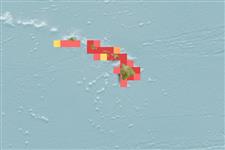Common names from other countries
Teleostei (teleosts) >
Kurtiformes (Nurseryfishes, cardinalfishes.) >
Apogonidae (Cardinalfishes) > Apogoninae
Etymology:
Issue
Junior synonym Apogonichthys zuluensis Fowler, 1934 of this species is considered a synonym of Foa madagascariensis (by Fraser et al. in review) (Ref. 93673) or Foa fo (T. Fraser, pers.comm. 16/03/2019).
Environment: milieu / climate zone / depth range / distribution range
Ecology
Marine; freshwater; brackish; reef-associated; depth range 0 - 134 m (Ref. 27665). Tropical
Central Pacific: Endemic to Hawaii.
Size / Weight / Age
Maturity: Lm ? range ? - ? cm
Max length : 6.4 cm SL male/unsexed; (Ref. 93673)
Dorsal spines (total): 9; Dorsal soft rays (total): 9; Anal spines: 2; Anal soft rays: 8; Vertebrae: 24. This species is distinguished by the following characters: pored lateral-line scales usually 9-10 and 14-16 gill rakers and rudiments on first gill arch; body scales with narrow dark margins; body uniform to mottled brownish without darker bars on sides (except at night); the second dorsal fin, anal fin and caudal fin pale are without darkish banding; pectoral fin with no whitish spot at axil; without whitish spots at base of caudal peduncle or behind posterior base of second dorsal fin; two darkish small marks near base of caudal peduncle (Ref. 93673).
Occurs among seagrasses, heavy algal growth, or rubble of shallow sheltered areas (Ref. 1602); sandy substrates (Ref. 76833). Readily enters brackish and also found in fresh waters (Ref. 27665). Benthic and benthopelagic (Ref. 58302).
Are mouthbrooders (Ref. 240). Distinct pairing during courtship and spawning (Ref. 205).
Fraser, T.H. and J.E. Randall, 2011. Two new species of Foa (Apogonidae) from the Pacific Plate, with redescriptions of Foa brachygramma and Foa fo. Zootaxa 2988:1-27. (Ref. 93673)
IUCN Red List Status (Ref. 130435)
CITES (Ref. 128078)
Not Evaluated
Threat to humans
Harmless
Human uses
Fisheries: commercial; aquarium: commercial
Tools
Special reports
Download XML
Internet sources
Estimates based on models
Preferred temperature (Ref.
115969): 24.2 - 28.8, mean 27.5 (based on 984 cells).
Phylogenetic diversity index (Ref.
82804): PD
50 = 0.5039 [Uniqueness, from 0.5 = low to 2.0 = high].
Bayesian length-weight: a=0.01122 (0.00528 - 0.02384), b=3.10 (2.92 - 3.28), in cm Total Length, based on LWR estimates for this (Sub)family-body shape (Ref.
93245).
Trophic level (Ref.
69278): 3.5 ±0.5 se; based on diet studies.
Resilience (Ref.
120179): High, minimum population doubling time less than 15 months (Preliminary K or Fecundity.).
Fishing Vulnerability (Ref.
59153): Low vulnerability (10 of 100).
